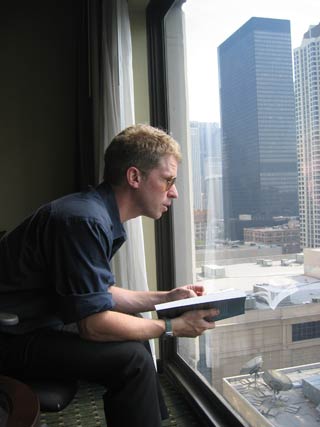J-M Reed, Photographer
Get to know a Buffalonian
Trained as an architect, J-M Reed is a photographer, a realtor, a former paramedic, and fire enthusiast. His photographs of house fires—he’s a regular, well known to local firefighters, whose alarms he tracks with a scanner—are part of a three-way exhibit that opens Friday, September 18 at ArtSpace. Called Ecologies of Decay, the show features Reed’s photos, Dennis Maher’s assemblages of materials scavenged from demolition site, and Julian Montague’s studies of the creatures that inhabit and contribute to the decay of urban structures.

How often do you go to the scene of a fire?
I go as often as I can—it is harder at night and during the winter, but they are the kind of things you just have to go to a lot of to get the image. I have learned over the years that how I approach a scene helps the pictures I will get. I try to avoid the route that the fire trucks will be primarily taking, and often approach the fires from the back.
What draws you to fire as a subject?
Part of it is a childhood fascination that I want to explore—but I also think this is really not that different. Most people may not admit it, but it must be of interest when the bulk of the daily news are fires, murders, and accidents. There are different ideas I am trying to explore. With the series Various Big Fires, I am investigating how the landscape changes during the event, and the fire scene as a whole. The Night Fires photographs for the Ecologies of Decay show are all about the spectacle of the urban fire scene. These fires are largely intentional and have become a part of the daily fabric of the city, and are, in fact, a form of entertainment. The other fire-related series I have been working on is Pink Houses, which are images of houses after they have burned. These are more specifically about loss, both the loss of home, and of dreams. The home is the symbol of the American Dream, so these images are about the erosion of that. I do think art is about self-exploration, not necessarily personal, but in a philosophical way about the world we live in.
Tell us a little about Ecologies of Decay.
It all came together quickly, and by all of us (myself, Dennis Maher, and Julian Montague) realizing we were thinking about the same overarching ideas in different ways. We immediately got strong support, so it started rolling quickly. We are all looking at the ecologies, or environments, that exist because of and during the process of urban decay. It is really important for all of us to present ideas in a very straightforward way, so I think for this reason our work works really well together as a solidified idea. We hope that people will come away from the show with a different understanding of the city’s current state. Each person may read it differently, but we hope that it will help provoke discussion. I have to say, too, that seeing it installed, I was pretty impressed by what we accomplished.
What do the firefighters make of your presence ate fire scenes?
I think they have gotten used to me. I try and stay out of the way, but I think they also like their pictures being taken. The fire service has a long, very traditional history, and preserving that history by saving artifacts and taking photographs is a big part of that. They probably also think I’m a bit nuts.
Have you ever been mistaken for an arsonist? Are you ever tempted to set fire to something—say a painting, or the sort of assemblage Dennis Maher creates—in order to document its desctruction?
I have not—I was a paramedic for 12 years in Buffalo, and I have gone to so many fires that I am a regular fixture. I have provided my photos at times to the fire investigators when they think they might help them. I do think it would be an interesting exercise to create the event, sort of like Cai Guo-Qiang’s fireworks performances and paintings. There is also a history of this: There were staged fires, sort of like movie set fires, at places like Coney Island in the 19th century. They would have firemen come and rescue people and put out the fire for a crowd of paying onlookers. But I think mostly that I am drawn to the unexpected-ness of these events, and the danger and excitement that comes with that. I am drawn more to the event/spectacle than to the fire itself, which ultimately terrifies me.
blog comments powered by Disqus|
Issue Navigation> Issue Index > v8n38 (week of Thursday, September 17, 2009) > J-M Reed, Photographer This Week's Issue • Artvoice Daily • Artvoice TV • Events Calendar • Classifieds |









 Current Issue
Current Issue